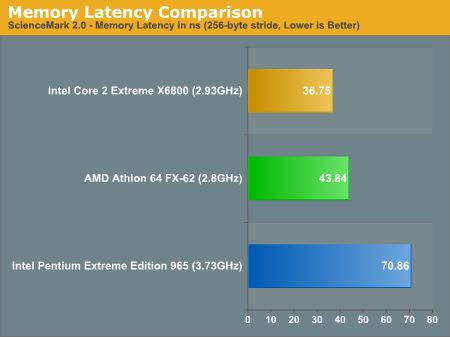Intel's Core 2 Extreme & Core 2 Duo: The Empire Strikes Back
by Anand Lal Shimpi on July 14, 2006 12:00 AM EST- Posted in
- CPUs
Memory Latency: No Integrated Memory Controller Necessary
One thing we pointed out in our earlier preview coverage of Intel's Core 2 Extreme is that the new processors have extremely low latency memory access, despite relying on the same memory controller as the previous generation of Intel CPUs.
Without an on-die memory controller Intel's Core 2 processor must use the memory controller in its chipset, which currently means the 128-bit DDR2 memory controller in either Intel's 965 or 975X chipset. The confusing thing is that although the Core 2 processors use the same memory controller as the old NetBurst processors, memory latency has been improved tremendously:

Intel's Core 2 processors now offer even quicker memory access than AMD's Athlon 64 X2, without resorting to an on-die memory controller. While Intel will eventually add one, the fact of the matter is that it's simply not necessary for competitive memory performance today thanks to Intel's revamped architecture. Update:As many astute readers have pointed out, Core 2's prefetchers are able to work their magic with ScienceMark 2.0, which results in the significant memory latency advantage over AMD's Athlon 64 FX-62. This advantage will not always exist; where it doesn't, AMD will continue to have lower latency memory access and where it does, Intel can gain performance advantages similar to what ScienceMark 2.0 shows.
| CPU | Everest |
CPU-Z 1.35 (8192KB, 128-byte stride) | CPU-Z 1.35 (8192KB, 64-byte stride) |
| AMD Athlon 64 FX-62 (2.8GHz) | 45.9 ns | 43.2 ns | 19.3 ns |
| Intel Core 2 Extreme X6800 (2.93GHz) | 59.8 ns | 52.8 ns | 10.9 ns |
Because of the Core 2's intelligent prefetchers doing too good of a job with ScienceMark memory latency test, we wanted to also showcase situations where Core 2 would feature slower memory accesses than the AMD platform with its integrated memory controller. Everest's results are more in line with what we'd expect to see, with the FX-62 offering over 23% faster memory accesses than the X6800. CPU-Z's latency tool also reported somewhat similar findings, with an 18% performance advantage due to AMD's integrated memory controller. CPU-Z also provided us with numbers that showcase how well Core 2 can perform if its prefetchers are able to "guess" correctly; at lower strides the Core 2 Extreme manages faster memory access than the FX-62. The 128-byte stride numbers are indicative of what will happen if the pre-fetchers are not able to get the Core 2 the data it needs, when it needs it, while the 64-byte numbers show you what can happen when things go well.










202 Comments
View All Comments
Anand Lal Shimpi - Friday, July 14, 2006 - link
Corrected, it was a misprint.Take care,
Anand
Zorba - Friday, July 14, 2006 - link
Why is the article talking about how Intel is killing AMD on power consumption when AMD is on the top for both idle and load? If you are doing a performance/watt ratio you need to show that on the graph. This page (page 7) just makes the how article look completely baised.Calin - Friday, July 14, 2006 - link
Because the EE SFF processors were hard to obtain by Anandtech even for testing purposes. I'm not sure they are available in retail market any more than Conroe isAnand Lal Shimpi - Friday, July 14, 2006 - link
The Core 2 Extreme X6800 has a performance per watt score of 0.3575 in WME9 compared to 0.2757 for the X2 3800+ EE SFF. I'll put together a performance per watt graph now and see if I can stick it in there.Take care,
Anand
Anand Lal Shimpi - Friday, July 14, 2006 - link
I included the performance per watt scores I mentioned above in the review now, hopefully that will make things a little more clear.Take care,
Anand
JarredWalton - Friday, July 14, 2006 - link
I don't see the chart, Anand - I hope I didn't accidentally overwrite your change. Sorry!MrKaz - Friday, July 14, 2006 - link
Don't put it because it's a biased chart,Why based on WM9 benchmark? Why not one of the others?
Why put it now, if you never put it when A64 was killing the P4s?
coldpower27 - Friday, July 14, 2006 - link
Because AMD didn't real make a big deal about the performance per watt intiative back in the day. They focused on their price/performance instead.MrKaz - Friday, July 14, 2006 - link
So?Just because Intel focuses now on that Anandtech must be obliged to put it?
So for you where was the price/performance (A64 vs P4) charts on Anandtech reviews?
coldpower27 - Friday, July 14, 2006 - link
Yeah, due to their making people aware of it, it has now become a issue.It was only after Prescott, that we became more aware that thermals were starting to get out of control and paid more attention to wattage numbers.
Price/Performance is not as hard to calculate.